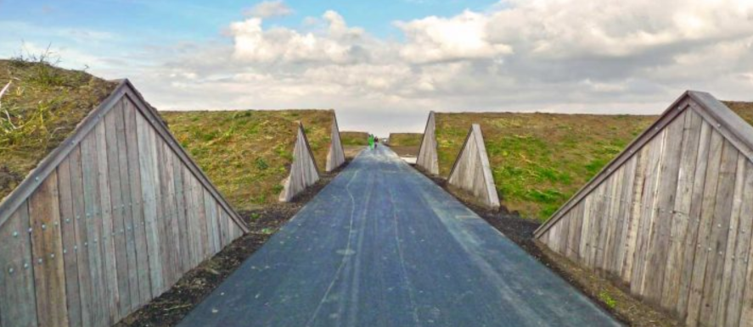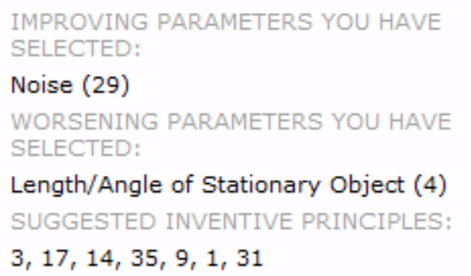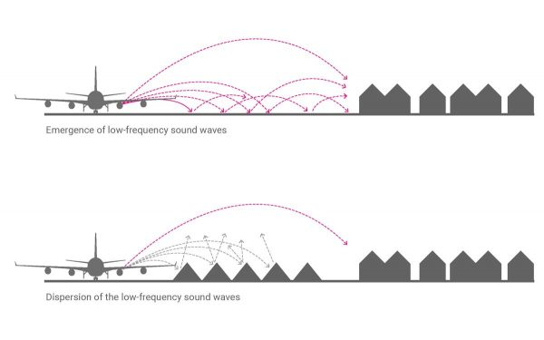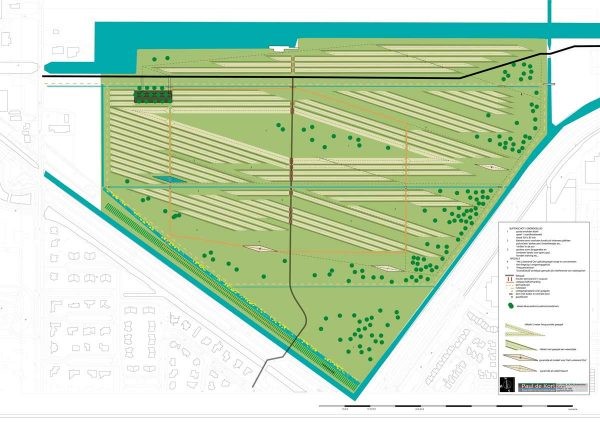In the Netherlands, a combination of geographical size, flat landscapes and frequent flights conspired to makes aircraft noise a vexing problem.
In the early 2000s, Amsterdam locals, frustrated with sound pollution, demanded the city do something to address the problem. Faced with lots of flat land around the airport, it was understood that traditional barrier solutions would not work for the most disturbing low frequency/long wavelength parts of the noise spectrum. Airport staff, once they began to look for alternative solutions, realised that plowed fields in the area seemed to help dampen the noise. Especially ones with a particular spacing of ridges.
Reverse-engineering this phenomenon, landscape architects worked with artist Paul De Court and drew on the work of acoustician Ernst Chladni to create over 100 grassy pyramids specifically designed to address this site-specific problem.

From a TRIZ perspective, the problem being solved represents a classic contradiction: we want to reduce noise, and what stops us are the long wavelengths of the most troublesome low frequencies. Here’s what this problem looks like when mapped onto the Contradiction Matrix:

And there is Principle 17, Another Dimension as the second most frequently used solution strategy for this conflict pair. Here’s how this solution works from an acoustic perspective at the Land Art Park:

Interesting, too, if we look at the overall pattern of ridges used by the architects, is how they’ve incorporated several Principle 3, Local Quality strategies so not all of the ridges are the same height, shape or orientation:

That solution alone would have merited looking at this story. The architects on the project, however, also went a step further by thinking about the next contradiction: we need ridges to solve the noise problem, but we don’t want to lose the potential to use the ridged area for other things. One of the Inventive Principles the Matrix recommends always considering for this kind of unwanted side-effect problem is 22, Blessing in Disguise.
A strategy the architects used with some aplomb. Firstly, by instead of simply disrupting sound waves, incorporating paths for cyclists and pedestrians, and then creating ‘…vistas and lines of sight, smaller and bigger allowing ‘rooms’ to emerge, which can be used for sports and cultural events. To the north and south the grassy ridge structure extends until it dissolves into longitudinal pyramids, distributed along the edges. Unique art objects are placed on the pyramids, inspired by parabolic sound mirrors, exploring the meaning of sound in this soundscape.’
Then, in a final Blessing in Disguise masterclass, the architects also engineered spaces that specifically amplify rather than reduce the aircraft noise, turning a former regional frustration into a highly localised aural experience.
One Inventive Principle good; three, better. Same as it ever was.
